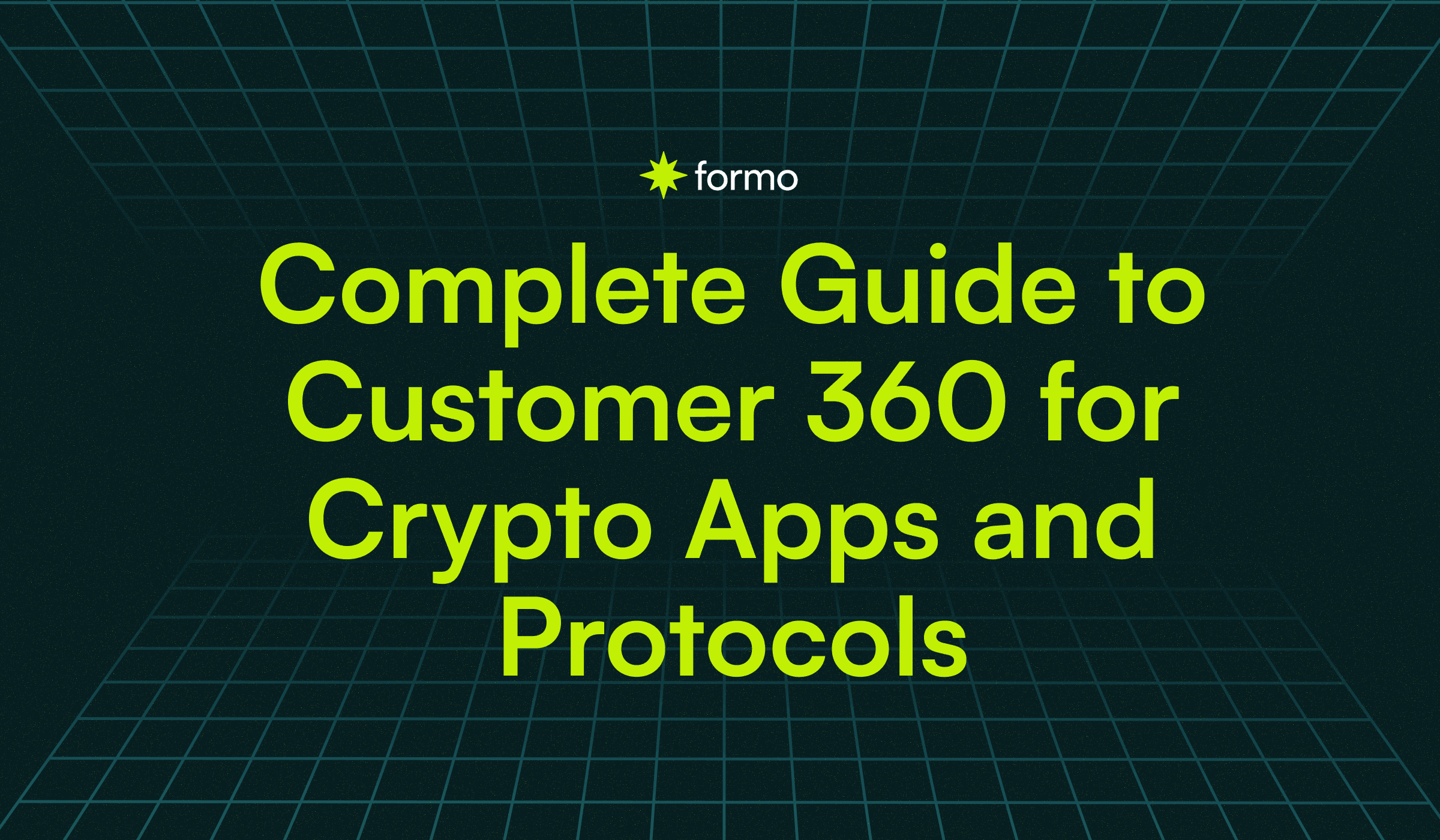Launching a Web3 product is just the beginning — guiding users through the right journey is the real challenge. If your onboarding isn’t converting, your funnel may be the problem. Users might lose interest, struggle to understand your product, or drop off before completing meaningful actions.
In this guide, you’ll learn how Web3 funnel analytics helps track both onchain and offchain user behavior, pinpoint drop-off points, and optimize every stage of the journey — from awareness to retention. With the right approach, you can boost engagement, increase conversions, and grow a loyal Web3 community.
Key Takeaways
Web3 funnels track both onchain and offchain user behavior for deeper insights.
High drop-offs? Web3 funnel analysis pinpoints exactly where and why users disengage.
Trust & education are critical to guiding users through complex Web3 concepts.
Optimization means action: simplify onboarding, add motivation, and offer guidance.
Formo helps Web3 teams map user journeys, reduce friction, and grow sustainably.
Web3 funnel analytics simplifies complex user journeys across fragmented touchpoints
What is Web3 Funnel Analytics?
A marketing funnel is a framework that guides users through key stages — awareness, consideration, conversion, and retention. In the Web3 space, where user journeys are often fragmented across onchain and offchain interactions, optimizing each stage is even more critical.

Web Funnel vs. Mobile App Funnel
Web3 Funnel Analytics goes beyond traditional marketing funnels by tracking and analyzing user interactions on decentralized platforms (dApps). Unlike Web2 analytics, which relies on centralized data sources, Web3 analytics leverages fragmented data to monitor user behavior.
By tracking wallet connections, token transfers, and onchain interactions, Web3 Funnel Analytics provides deep insights into user activity. This data helps teams refine their marketing strategies, optimize onboarding processes, and increase conversion rates.
Why do you need a Web3 Marketing Funnel?
A Web3 marketing funnel is critical because it helps simplify complex user journeys and drive real product adoption. Here's why it matters:
Navigating Complexity
Web3 products often involve complex concepts such as decentralization, token economies, staking, DAOs, and smart contracts. For many users, these ideas are unfamiliar or intimidating. A marketing funnel simplifies the learning curve, guiding users step by step from awareness to engagement and conversion.
Building Trust and Credibility
Trust is a major hurdle in the Web3 space. Users must believe in your project, team, and technology before they commit. A marketing funnel helps build trust through transparent information, real-world use cases, testimonials, and thought leadership content.
Educating and Engaging Users
Most potential users won’t understand your product immediately. A marketing funnel analysis gives you a signal to educate them through blog posts, tutorials, webinars, AMAs, and interactive demos, gradually leading them toward adoption.
Community-Driven Growth
Web3 thrives on community engagement. Unlike traditional products, where users are passive consumers, Web3 users are often contributors, stakeholders, and governance participants. A funnel helps nurture these relationships through ongoing communication, incentives, and governance involvement.
Maximizing Conversion Opportunities
Every interaction with your platform is a potential conversion point. Whether it’s getting users to sign up, mint an NFT, participate in governance, or stake tokens, a well-structured funnel ensures frictionless progression from one stage to the next. Web3 marketing funnel helps you focus your efforts, optimize user engagement, and maximize ROI.
Stages of a Web3 Marketing Funnel

Example of Web3 Marketing Funnel Chart
A Web3 funnel follows 6 key stages, each designed to move users toward active participation. Here’s how to optimize each one:
1. Awareness: Making Users Discover Your Web3 Product
At the top of the funnel, your goal is to capture attention and spark curiosity. Users might discover your product through social media, search engines, referrals, hackathons, or airdrops.
Key Tactics for Awareness:
Advertising: Run impression-based campaigns on platforms such as Twitter, Farcaster, and Warpcast.
Educational Content: Share blog posts, infographics, and explainer videos to introduce your product.
Influencer Partnerships: Collaborate with KOLs, community leaders, and YouTubers in the Web3 space.
Events & Hackathons: Join Web3 conferences, AMAs, and Twitter Spaces to increase visibility.
2. Interest: Engaging Potential Users
Once users are aware of your project, they’ll explore your website, read your documentation, or connect their wallets. At this stage, your goal is to keep them engaged and interested.
Key Tactics for Interest:
Interactive Demos & Tutorials: Let users test your product through sandbox environments.
Community Engagement: Actively participate in Discord, Telegram, and Web3 communities.
Use Cases & Success Stories: Showcase real-world applications and partnerships.
3. Consideration: Helping Users Make Informed Decisions
At this point, users are evaluating whether your product aligns with their needs. They may sign up, connect a wallet, or explore token utilities.
Key Tactics for Consideration:
Detailed Documentation & FAQs: Address common concerns.
Retargeting Ads: Re-engage previous visitors with customized ads.
Email Sequences: Send follow-ups based on user actions and interests.
4. Decision: Encouraging Users to Take Action
Users are now close to converting. Your job is to simplify the process and reduce friction.
Key Tactics for Decision:
Clear CTAs & Simple Onboarding: Remove unnecessary steps.
Social Proof & Case Studies: Showcase positive testimonials and success stories.
Incentives & Rewards: Provide bonuses or early access.
5. Action: Driving Conversions
The moment of conversion — users sign up, explore features, and make a purchase. Ensure a seamless experience to avoid drop-offs.
Key Tactics for Action:
Optimized UI/UX: Ensure a smooth, user-friendly onboarding and checkout process.
Customer Support & Live Chat: Offer immediate assistance to resolve friction.
6. Retention: Turning Users into Advocates
Retention is critical for sustained growth. Engaged users become brand advocates, governance participants, and repeat users.
Key Tactics for Retention:
Exclusive Community Access: Create private Telegram/Discord groups for loyal users.
Ongoing Education & Feature Releases: Keep users updated on product roadmaps and upgrades.
Loyalty & Rewards Programs: Incentivize long-term engagement with perks.
Web3 Funnel Marketing Analysis Case Study
Web3 funnel analysis example: A mid-stage Web3 wallet app noticed low user activation despite strong traffic from Web3 community campaigns and partner referrals. The team suspected drop-offs in the onboarding funnel but didn’t know exactly where or why. The goal here is to increase the activation rate, defined as a user completing their first onchain transaction after installing the wallet.
The team tracked the following 5 key steps:
Step | Funnel Event | Conversion Rate |
1 | Visited Landing Page | 100% |
2 | Clicked “Install Wallet” CTA | 72% |
3 | Wallet Extension Installed | 25% |
4 | Created New Wallet | 12% |
5 | First Onchain Transaction | 6% |
Drop-off: Step 2 → Step 3
From “Clicked Install” to “Installed Extension”
Drop-off: 72% → 25% (47% loss)
Hypothesis: Users clicked but didn’t follow through due to friction/confusion.
User Feedback: "Not sure what to do next," “I didn’t see the extension after clicking install.”
Fixes:
Added an in-product overlay with a 3-step install tutorial (Chrome, Brave, Firefox).
Linked to the FAQ and added extension store trust badges.
Drop-off: Step 3 → Step 4
From “Installed Extension” to “Created Wallet”
Drop-off: 25% → 12% (52% loss)
Hypothesis: Users hesitated due to concerns over wallet security or unclear next steps.
Heatmap Analysis: Users stalled on the seed phrase screen.
Fixes:
Added a one-click "Create Wallet with Social Login" (via Web3Auth).
Included trust signals: audited badge, social proof, and testimonials from known builders.
Added inline education: “What is a seed phrase?” tooltip.
Drop-off: Step 4 → Step 5
From “Created Wallet” to “First Transaction”
Drop-off: 12% → 6% (50% loss)
Hypothesis: Users didn’t know how to fund their wallet or what to do next.
Session Replay Insight: Users clicked around aimlessly or closed the app.
Fixes:
Added “Quick Start” modal after wallet creation:
Testnet faucet auto-funding
Suggestions: mint a free NFT, vote in DAO proposal, claim a POAP
Added onchain quest badge + notification: “Complete your first transaction to unlock Level 1!”
Learnings
Contextual onboarding matters: Walk users through each stage with in-app guidance.
Trust-building early on is critical: Before asking users to secure private keys, build confidence.
Motivation matters: Users need a reason to explore. Use quests, badges, or “first reward” incentives.
Analytics + user feedback = best combo: Funnels alone show where the problem is; qualitative data shows why.
Key Metrics to Track in Web3 Funnel Analytics
To measure the effectiveness of your Web3 funnel, track the following key metrics:
Wallet Connections: Track unique and returning users.
Engagement Rate: Monitor interactions with dApps and smart contracts.
Conversion Rate: Measure how many users complete key actions.
Drop-Off Rate: Identify weak points in the funnel.
Churn Rate: Track retention and user loyalty.
Optimize Your Web3 Funnel Analytics with Formo
A well-structured marketing funnel helps your Web3 product gain traction, foster a loyal community, and drive growth. Whether you are launching a social dApp, DeFi app, or growing an NFT ecosystem, funnel analytics helps you turn users into advocates. With Formo’s Web3 funnel analytics tools, you can track your user journeys, optimize onboarding, and build a better product.
Read more:
Web3 Cohort Analysis 101: What it is and real-world examples
Mastering Web3 Marketing Attribution Analytics: A Complete Guide
Customer Journey Analytics: the ultimate guide for beginners
Follow us on LinkedIn and Twitter, and join our community to learn how Formo turbocharges growth for leading teams across web3!
FAQs
1. How is Web3 funnel analytics different from Web2 funnel tools like Google Analytics?
Traditional Web2 analytics tools — like Google Analytics — primarily track website and app activity through centralized data such as page views, clicks, and form submissions. Web3 funnel analytics, on the other hand, captures onchain user behavior:
Wallet connections and activity frequency
Smart contract interactions (e.g., staking, governance votes)
Token transfers and NFT minting events
Cross-platform journeys across multiple dApps
This gives a holistic view of decentralized user journeys that Web2 tools can’t provide.
2. What tools or platforms can I use to track a Web3 funnel?
You can use specialized Web3 analytics platforms such as Formo, which:
Tracks both onchain and offchain interactions
Monitors wallet-level activity and user segmentation
Identifies drop-off points at each stage of the funnel
Combines Web3 blockchain data with Web2 analytics for full visibility
Other options include Dune Analytics for custom dashboards and Nansen for wallet intelligence, but these may require more technical expertise.
3. What’s a good “conversion” action in a Web3 funnel?
A conversion in Web3 depends on your product type and goals. Common examples include:
NFT projects: Minting an NFT or joining an allowlist
DeFi platforms: Staking tokens, providing liquidity, or borrowing/lending
DAOs: Voting on governance proposals or joining as a member
Wallet providers: Completing the first onchain transaction
In short — a conversion is any meaningful blockchain action that moves the user toward deeper engagement.
4. My project is still early stage. Should I set up funnel analytics now?
Yes — tracking early matters. Benefits of early funnel analytics:
Detect UX bottlenecks before scaling
Validate product-market fit with real behavior dataPrioritize onboarding improvements
Gather insights for investor updates and roadmap decisions
Early tracking saves you from scaling a flawed user experience and helps you optimize faster.
5. What are the signs my Web3 funnel needs fixing?
Look for these common warning signs:
High drop-off rates between wallet connection and first onchain action
Low activation rates despite good traffic
User confusion during onboarding (e.g., seed phrase setup, funding wallet)
Minimal repeat activity — users try once and never return
If you see these issues, run a funnel drop-off analysis and collect qualitative feedback to uncover the “why” behind the data.





